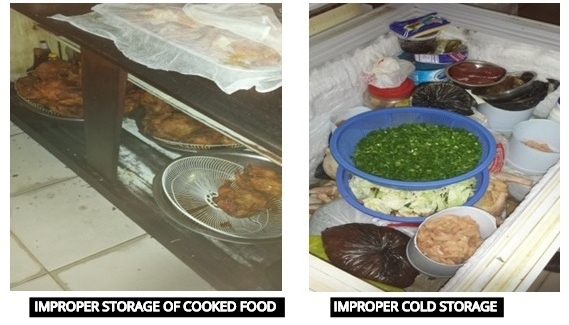Following a survey of 55 food service establishments in regions 4 and 6, the Guyana Food and Drug Department has found that a mere 18 percent protected food from contamination while only four percent of the establishments had workers who were observed applying the correct principles of cleaning and sanitising.
The survey was conducted from September 2018 to March 2019 among 55 randomly selected food service establishments in Region Four (Georgetown and Timehri-CJIA), and in Region Six (New Amsterdam and Corentyne, Berbice).
Guided by an inspection checklist, the survey saw a total of six areas being assessed: food storage, cold storage, food preparation, sanitation, garbage disposal, and employee hygiene.
This is according to Director of the Food and Drug Department, Mr. Marlan Cole, who revealed that, based on the findings, only 25 percent (14 of 55) of the facilities practised adequate food storage. It was also found that cold storage was satisfactory in 34 percent (19 of 55) of the facilities, and only 22 percent (12 of 55 facilities) had a functional temperature monitoring device (thermometer).
Regarding food preparation, only 18 percent (10 of 55 facilities) effectively protected the food from contamination, while a mere 11 percent (6 of 55 facilities) practiced meat thawing safely. Further, it was observed that food handlers in only 13 percent (7 of 55) of establishments used gloves. As it relates to sanitation, only four percent of the establishments (2 of 55) had workers who were observed applying the correct principles of cleaning and sanitising (dish-washing).
However, 73 percent (40 of 55), or the majority of establishments, had adequate external garbage disposal while 56 percent (31 of 55 establishments) had adequate temporary internal garbage disposal. With regards to employees’ hygiene, it was determined that only 20 percent (11 of 55 establishments) practiced hand-washing correctly and, in 42 percent (23 of 55) of the establishments, workers used no hair nets.
According to Cole, the survey also saw microbiological samples being taken of the food and also from workers’ hands (by way of swabs), from food contact surfaces, from food serving containers, and air quality.
Of the 99 food samples submitted, 37 percent (37 of 99) were unsatisfactory and, of the 102 hands of workers that were swabbed after washing, 47 percent (48 of 102) were unsatisfactory. Regarding food contact surfaces such as cutting boards and utensils, 30 percent of the 125 surfaces (38 of 125) swabbed after cleaning and/or sanitising were unsatisfactory. Forty six percent of the 48 food containers (22 of 48) sampled were unsatisfactory. Meanwhile, the air quality in the majority of establishments was generally satisfactory since 95 percent of the 64 air quality samples (61 of 64) taken were satisfactory.
The findings of the survey were shared with members of the National Food Safety and Control Committee Meeting which was hosted on May 7, 2019.
According to Cole, members are expected to take the detailed results and findings to food service establishments that fall under their purview, where they are to either work collaboratively with proprietors to ensure compliance with sanitary regulations or to take appropriate action in the very best interest of consumer protection and safety.













